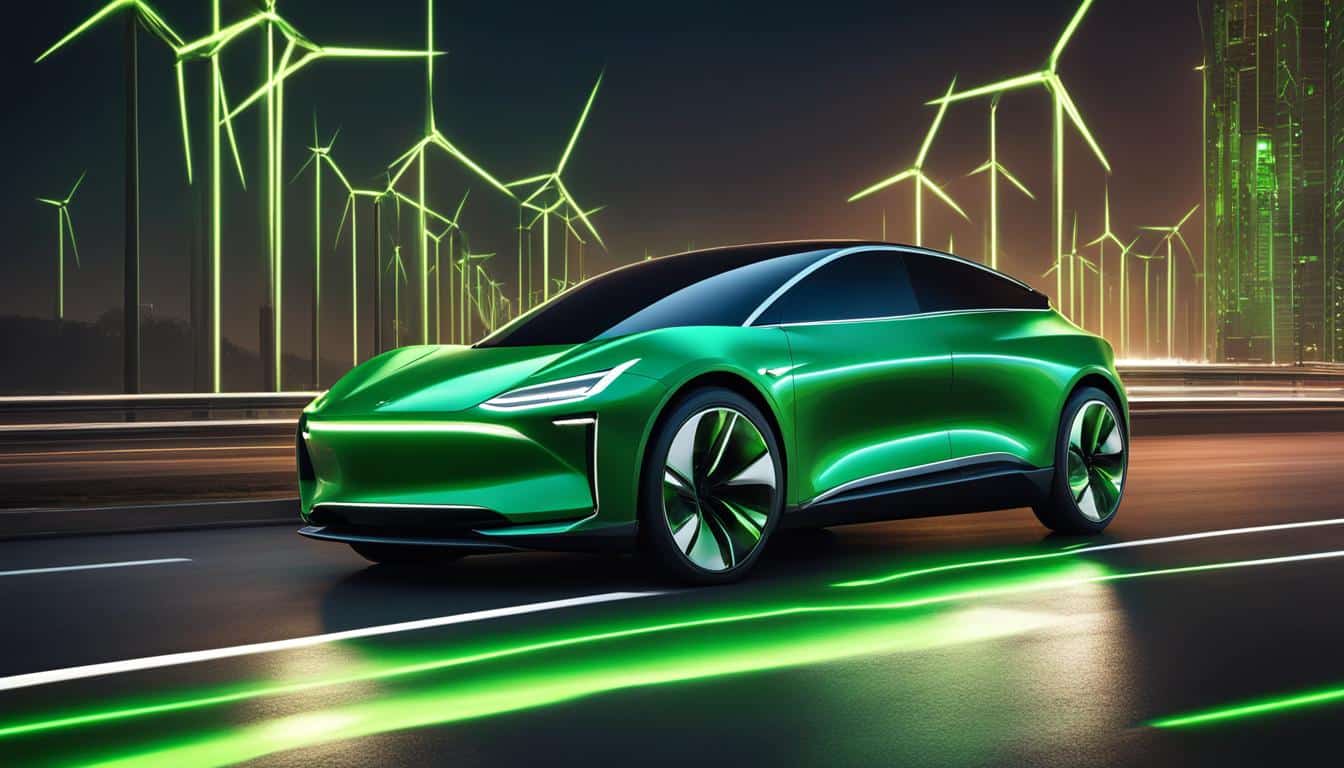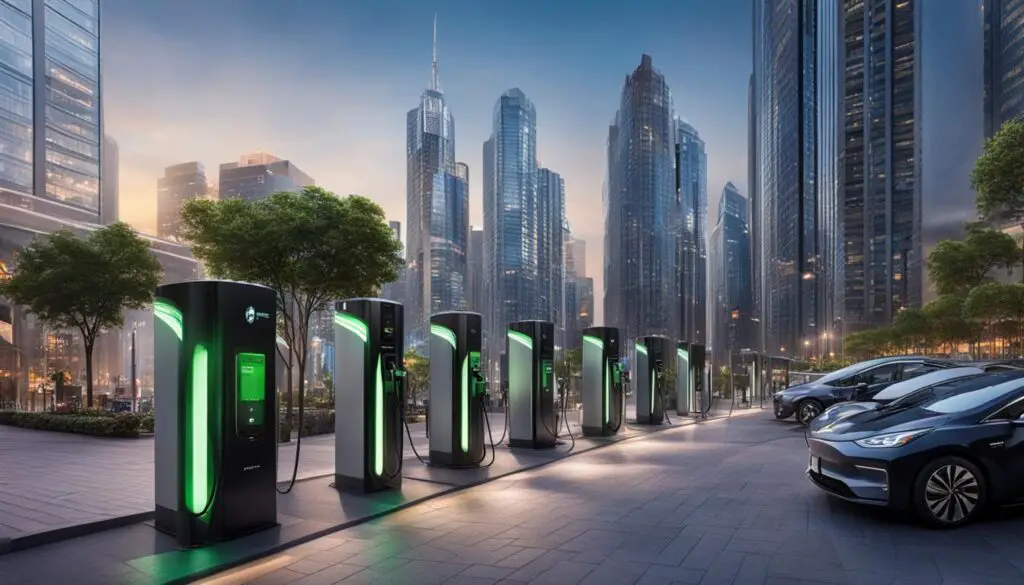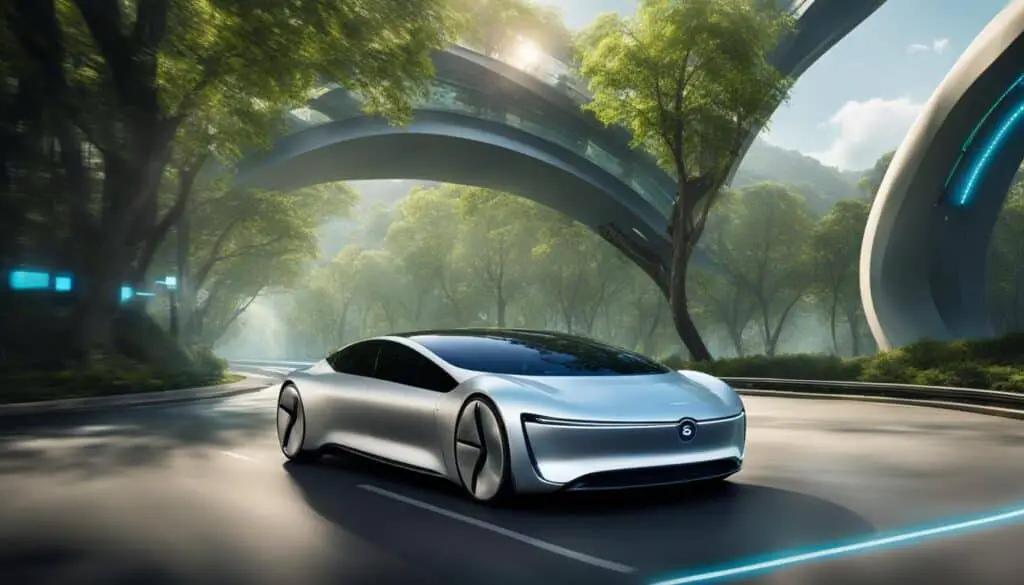
Next-Generation EVs: A Look at the Latest High-Tech Features
I am excited to explore the latest advancements in electric vehicle technology and delve into the high-tech features that are shaping the future of EVs. The automotive industry is undergoing a groundbreaking transformation, with electric vehicles at the forefront. Governments and environmentalists alike are advocating for EVs as a way to revolutionize transportation and reduce carbon emissions.
Continuous advancements in battery technology have resulted in EVs with longer driving ranges, faster charging, and improved performance. For example, Toyota has developed an impressive 745-mile battery, addressing the issue of range anxiety and making EVs more practical for everyday use. This is just one example of how electric vehicle technology is pushing boundaries and revolutionizing the way we drive.
But it’s not just about the batteries. The success of EVs also relies on the development of a robust charging infrastructure. As governments and private entities invest in charging networks, convenient and accessible charging options are becoming more readily available. This growth in charging infrastructure is essential to support the increasing number of EVs on the road and encourage the transition to sustainable transportation.
In addition, autonomous driving technology is another crucial aspect of the future of EVs. Tesla has been a leader in this field, with their self-driving features setting the standard in the industry. The integration of autonomous driving technology in EVs opens up new possibilities for shared autonomous fleets, transforming transportation as we know it.
Sustainable materials and manufacturing practices are also being adopted by automakers to reduce the environmental impact of EV production. As we look ahead to the future of electric vehicles, it’s clear that innovative technology, sustainability, and a transportation transformation are on the horizon.
Key Takeaways:
- Advancements in battery technology are driving the transition towards sustainable transportation
- A robust charging infrastructure is crucial for the widespread adoption of EVs
- Autonomous driving technology holds promise for a greener and more efficient future of transportation
- A shift towards sustainable materials and manufacturing practices is reducing the environmental impact of EV production
- The future of electric vehicles presents an era of innovation, sustainability, and seamless connectivity
Breakthroughs in Battery Technology for Longer Range and Faster Charging
One of the key factors driving the widespread adoption of electric vehicles (EVs) is the continuous advancements in battery technology. Automakers like Toyota are at the forefront, pushing the boundaries with breakthroughs in battery chemistry.
These advancements have resulted in batteries with longer driving ranges, allowing EVs to travel greater distances on a single charge. This addresses the issue of range anxiety, a common concern among potential EV buyers, and makes EVs more practical for everyday use.
Not only are EVs capable of longer ranges, but they also benefit from faster charging times. With improved battery technology, charging an EV has become more efficient and convenient. EV owners no longer have to wait for extended periods to recharge their vehicles, enabling them to get back on the road quicker.
Beyond longer ranges and faster charging, breakthroughs in battery technology have also led to improved overall performance in EVs. The power and acceleration of electric vehicles have significantly increased, offering a thrilling driving experience comparable to that of traditional combustion engine vehicles.
Toyota’s recent development of a 745-mile battery demonstrates the remarkable progress in battery technology and its potential to revolutionize the EV industry.
These advancements in battery technology are instrumental in driving the transition towards sustainable transportation and reducing reliance on fossil fuels. As EVs continue to evolve and become more accessible to the masses, the breakthroughs in battery technology will play a crucial role in shaping the future of transportation.
Advancements in Battery Technology: A Comparative Overview
| Automaker | Battery Advancement | Impact |
|---|---|---|
| Toyota | Development of a 745-mile battery | Addresses range anxiety and offers practicality for everyday use |
| Tesla | Implementation of high-capacity batteries | Enables longer driving ranges and faster acceleration |
| GM | Utilization of solid-state battery technology | Potential for faster charging and increased energy density |
| BMW | Advancement in battery cooling systems | Enhances battery longevity and performance |
The Importance of a Robust Charging Infrastructure for EV Adoption
While advancements in battery technology are critical for the success of EVs, the availability of a robust charging infrastructure is equally important. Currently, the slow process of installing charging stations is hindered by laws and weak electrical grids. However, governments and private entities are investing heavily in charging networks to provide convenient and accessible charging options for EV owners.
As charging infrastructure expands, the barriers to EV adoption will continue to diminish, making EVs a more viable option for consumers. The growth of the charging infrastructure is essential to support the increasing number of EVs on the road and encourage the transition to sustainable transportation.
Benefits of a Robust Charging Infrastructure
A robust charging infrastructure offers numerous benefits for EV adoption:
- Convenience: With a widespread network of charging stations, EV owners can easily find charging points wherever they go, eliminating range anxiety and providing peace of mind.
- Accessibility: A comprehensive charging infrastructure ensures that EV charging is accessible to all, regardless of their geographic location or living arrangements. This inclusivity promotes widespread EV adoption.
- Flexibility: Different types of charging options, such as fast chargers and slow chargers, cater to various needs and time constraints. This flexibility allows EV owners to choose the most suitable charging method for their requirements.

The Role of Public-Private Partnerships
Building a robust charging infrastructure requires collaboration between governments, private companies, and other relevant stakeholders. Public-private partnerships play a crucial role in accelerating the deployment and expansion of charging networks.
A robust charging infrastructure is essential to unleash the full potential of electric vehicles and drive their widespread adoption. By working together, governments and private entities can create a seamless charging experience for EV owners, laying the foundation for a sustainable transportation future.
Investment in Charging Networks
Governments and private entities worldwide are investing significant resources to develop and expand charging networks. These investments include:
| Country | Investment |
|---|---|
| United States | $7.5 billion federal investment to deploy 500,000 charging stations by 2030 |
| China | $1.5 billion investment to build 200,000 public charging stations by 2025 |
| Germany | €500 million investment to install 50,000 public charging points by 2030 |
These investments highlight the commitment to developing a robust charging infrastructure globally, accelerating EV adoption, and paving the way for a sustainable transportation revolution.
The Role of Autonomous Driving Technology in the Future of EVs
The future of electric vehicles (EVs) is evolving rapidly, driven by advancements in autonomous driving technology. Tesla, a leading automaker in the EV industry, has set the standard with its self-driving features, revolutionizing road safety and enhancing convenience. Other prominent players such as General Motors (GM) and BMW are also making significant strides in autonomous driving technology, contributing to the overall transformation of the transportation industry.
Autonomous driving technology goes beyond mere hands-free driving. It opens up new possibilities for shared autonomous fleets, which have the potential to redefine transportation as we know it. By introducing shared autonomous fleets, we can optimize the utilization of vehicles, reduce traffic congestion, and enhance overall transportation efficiency. This paradigm shift has the potential to revolutionize the way we commute, travel, and experience mobility.
However, the integration of autonomous driving technology in EVs may face some resistance from the public, especially among those who are skeptical of EVs themselves. Convincing skeptics of the potential benefits and safety of autonomous electric vehicles is a crucial aspect of achieving widespread adoption. Education and transparency will play key roles in addressing concerns and dispelling misconceptions surrounding autonomous driving technology and its impact on the future of transportation.
With autonomous driving technology paving the way for a greener and more efficient future, the synergy between EVs and self-driving features holds immense promise. As these technologies continue to advance, we can look forward to a transportation landscape that is not only sustainable but also seamless, safe, and convenient for all.

The Potential of Shared Autonomous Fleets
Shared autonomous fleets have the potential to revolutionize transportation by optimizing the utilization of vehicles and reducing traffic congestion. By leveraging autonomous driving technology, these fleets can operate efficiently and provide seamless, on-demand transportation services.
| Benefits of Shared Autonomous Fleets | Implications for Transportation |
|---|---|
| Reduced number of vehicles on the road | Less traffic congestion and improved air quality |
| Increased transportation accessibility | Enhanced mobility options for all individuals |
| Cost-effective commuting | Reduced individual private vehicle ownership |
| Enhanced safety | Reduced human error and potential accidents |
Advancements in Autonomous Driving Technology
“Autonomous driving technology has experienced significant advancements in recent years. These innovations have paved the way for safer and more efficient transportation, with Tesla at the forefront of this revolution.” – Elon Musk, CEO of Tesla
Autonomous driving technology has come a long way, with continuous advancements in sensors, artificial intelligence, and data processing capabilities. These advancements enable vehicles to perceive and navigate the surrounding environment, making driving safer and reducing the risk of accidents caused by human error.
The integration of autonomous driving technology in EVs offers numerous benefits, including:
- Improved road safety: Autonomous features have the potential to significantly reduce human errors behind the wheel, making roads safer for all users.
- Enhanced convenience: Self-driving features eliminate the need for constant attention while driving, providing a more relaxed and enjoyable experience for EV owners.
- Increased productivity: With autonomous driving technology, EV owners can utilize their travel time more efficiently, whether for work, leisure, or relaxation.
The future of EVs relies heavily on the continued development and integration of autonomous driving technology. As self-driving features become more sophisticated and widespread, the transportation landscape will undergo a profound transformation, creating a greener, safer, and more efficient future.
Conclusion
The future of electric vehicles holds immense promise and potential for the automotive industry. Through the continuous advancements in battery technology, the growth of a robust charging infrastructure, and the integration of autonomous driving technology, we are witnessing a transformative era of innovation, sustainability, and transportation revolution.
As we move forward, it is evident that EVs will play a significant role in reducing carbon emissions and creating a greener, safer, and more efficient transportation system. The relentless pursuit of innovative technology in the EV sector is reshaping the automotive landscape, providing us with exciting opportunities to embrace sustainable energy and create a better future.
The road ahead is filled with endless possibilities. By embracing electric vehicles and their accompanying technologies, we are not only fostering a sustainable environment, but also embracing a transportation transformation that will benefit us all. The future of electric vehicles is not just about the vehicles themselves, but about enhancing connectivity, optimizing energy consumption, and reshaping the way we move and experience transportation.
Join us on this transformative journey as the automotive industry leads the way into a future of innovation, sustainability, and transportation revolution. Together, we can drive the change needed to create a greener and more connected world.
FAQ
What are some of the latest advancements in electric vehicle technology?
The latest advancements in electric vehicle technology include breakthroughs in battery technology, the integration of autonomous driving features, and the use of sustainable materials in EV production.
What high-tech features can I expect to find in next-generation EVs?
Next-generation EVs will come equipped with high-tech features such as longer driving ranges, faster charging times, improved performance, autonomous driving capabilities, and seamless connectivity.
How have advancements in battery technology improved EVs?
Breakthroughs in battery technology have resulted in EVs with longer driving ranges, faster charging times, and improved overall performance, making them more practical and convenient for everyday use.
Why is a robust charging infrastructure important for EV adoption?
A robust charging infrastructure is crucial for EV adoption as it provides convenient and accessible charging options for EV owners, reducing the barriers to entry and making EVs a more viable option for consumers.
What is the role of autonomous driving technology in the future of EVs?
Autonomous driving technology plays a significant role in the future of EVs, enhancing road safety and convenience, and opening up possibilities for shared autonomous fleets that could transform transportation as we know it.
